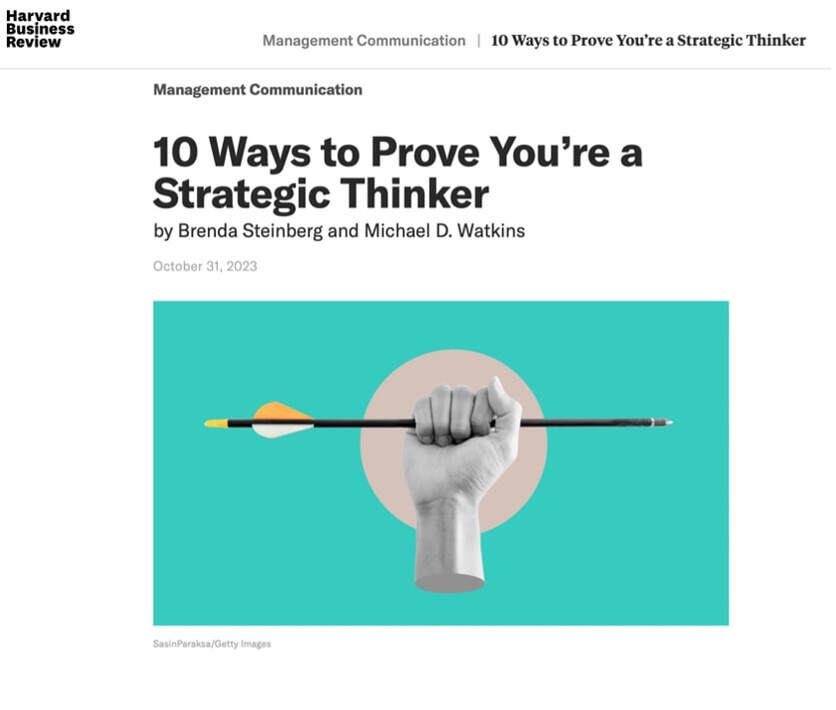 Years ago, I read an article that suggested that, in order to be the smartest person in the room, you had to do only one thing...listen! They argued that simply paying attention to the conversation in a meeting gives you a leg up over all the other great minds in the room. Years later, I find it’s true. Given the temptation to multitask and the distractions that we all face during the workday, it’s no wonder that paying attention is now a special skill that requires discipline—and that stands out. I was thinking about the importance of listening (fully) in a meeting as I read this fabulous HBR article “10 Ways to Prove You’re a Strategic Thinker,” by Brenda Steinberg and Michael D. Watkins. The article stands out because it’s a practical breakdown of behaviors and actions that define what it means to “be strategic,” a concept which can sometimes be squishy. The authors talk about both thinking strategically and the related skill, communicating. As an organization development consultant and executive coach, I have worked with leaders for more than 20 years. I find that, to many people, being strategic means drawing a strategy on a slide. Well, yes and…there’s a lot more to it. The article outlines specific ways to be a strategic thinker and communicator. For example, demonstrating that you are informed, building on ideas, and connecting the dots between ideas. If you are at the director or division-lead level, for example, paying attention to the broader discussion across your organization, and becoming informed on other groups’ activities and plans is what you need to develop an enterprise-wide view. That’s the big-picture. Leading your Team vs. Leading with your Peers As an executive coach, I find that many of the leaders I work with excel when it comes to leading their teams. In preparation for a team event or meeting, they actively engage, plan out talking points, and block time to ensure they minimize distractions. They show up. They listen fully and are able to ask those great “look ahead” questions, map ideas to the strategy, and engage the group. When it comes to gatherings of peers, however, these same leaders may not prepare as much. They may allow their minds to drift if a peer is briefing on another area of the business, or they may send a delegate if they are double booked. In some cases, they don't even show up. What’s the perception with their peers? It could be a view of a leader who is unprepared, siloed, not totally present… Their peers don’t see the strategic thinking in action. Why is this so important? Besides the fact that you’re missing opportunities to collaborate and provide more value to the organization, from a personal development perspective, if your desire is to be promoted, peer feedback and adding value at the peer level is critical. If your cohort doesn’t feel that you’re ready to move up, you will likely not be promoted regardless of how well you manage your own team and projects. We typical say that early in your leadership career, you’re looking up and down, but as you grow, it’s critical to look up and out. How to Make the Shift
As the article outlines, being strategic starts with the small efforts. Little things like preparing in advance for a meeting by reading the presentation materials, and getting curious about other people’s work, is what it’s all about. Connecting the dots could be as simple as pointing out interconnections or cause/effect outcomes across groups. Another strategy with peers is to offer support. “How can I help?” is a powerful invitation to a colleague who has just escalated a risk to the organization or who is stuck on a challenge. Of course, you want to be careful not to overly commit yourself but some simple strategies like asking a powerful question of a colleague about work that has little to no impact on your area, is a powerful value-add and will position you as a strategic thinker. What are some simple ways you can shift your engagement and contribute at your peer level?
0 Comments
Your comment will be posted after it is approved.
Leave a Reply. |
AuthorLaura Mendelow |
|
|
©2020. All Rights Reserved. Mendelow Consulting Group, LLC.

